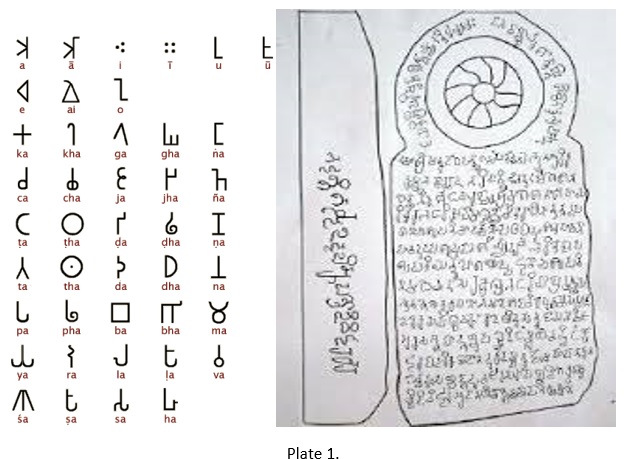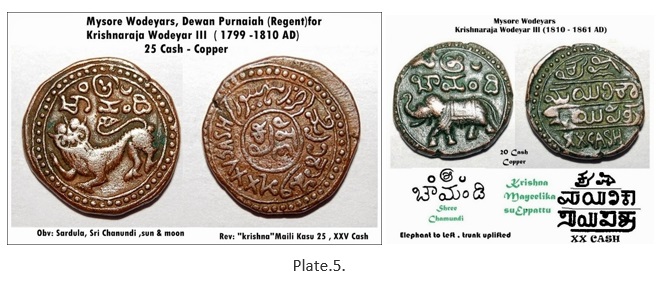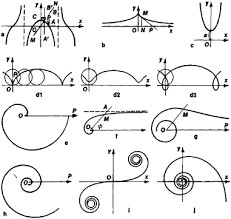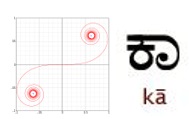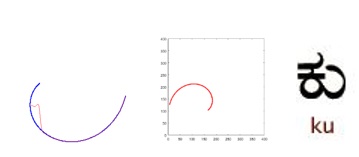Abstract
An inquiry as to why the alphabets of the script of Kannada language of Karnataka state, South India, are so full of curves and spirals motivated me to know more about the science behind spiral patterns and understand its application in Kannada alphabets. Circles and spirals occur naturally in cosmos and on the earth. The shape of cusps and spirals on sand dunes, sea waves, sea shells, the flowers and tendrils etc. all exhibit spiral patterns that can be studied with a scientific approach. The knowledge and application of geometry that pervaded the visual world, was the fundamental basis for the construction of fire altars even during the Vedic Civilization. The aesthetic beauty of circular designs and its harmony with nature as spirals curves have inspired mankind all through the ages to imitate them in the artistic creations. On a philosophical note, curves and spirals indicate extension, un-interruptions and continuity much like that of breathing in life. Probably, in the process of transferring circles and curves of nature to perfect artistic rendering, the geometric formulation got evolved. Orientation of curves and circles in artistic depictions may be horizontal, vertical, algebraic curves (where they observe an algebraic equation) or a transcendental where curves are not algebraic in pattern (like circle, helix, hyperbola or parabola). The fact whether the linguists of ancient period were proficient in geometric curves like other artists and sculptors to adopt them in script, or inspired by the curves of nature, needs to be explored. Spirals by themselves are not phonetic symbols. They are loci of a point which moves in a definite pattern. It is also probable that spirals were adopted in language because both spirals and language had the common feature of an eternal flow and aesthetic sense. Geometric form allows one to reconstruct and remember the structure. The enquiry as to why Kannada letters have many curves may be that the structuring of letter was based on certain sounds produced by the articulation of vocal organs. Ancient Indian thinkers of southern region held certain views about the origin and propagation of sound. According to ‘Sabarabhasya’, compiled by Sabaraswamin of 5th century C.E, sound was a wave motion in air, originated by an impact and transmitted by the minute particles of air. The knowledge about the physical production of sound through breath, voice, the tongue and lips was merged with the intricate knowledge of geometry of curves and the letters in Kannada could have got styled on the combined knowledge of both.
This paper explores various meaningful comparison of arcs of circles, geometric spirals and other mathematical curves that got introduced either singly or in combination in the Kannada alphabets as far back as the 9th century C.E with almost no usage of an angular or straight strokes. This feature got maintained and evolved with minor changes in the present day alphabets of “Kannada Varnamale”- the alphabets of Kannada language. It is an attempt to show that the evolution of paleography of Kannada might have been influenced by the knowledge of circle geometry, spirals and curves to illustrate a phonetic sound in an alphabet.
Beginning of script from Brahmi to Halmidi script
The earliest form of symbol inscription can be seen in the Indus seals, (of 2000 B.C approximately) which are yet to be deciphered as to whether they are alphabets with of phonetic value or symbols of ideas. The archaeological proof of script in India, as a source of communication begins with the Brahmi script. Brahmi is the name given to the oldest system of writing that was used in south and central Asia during the final centuries BCE, and early centuries CE. Brahmi-the ancestor of most of the modern Indian languages appears on the edicts of King Ashoka (c 270- 232 B.C) and is the archaeological proof for the usage of this script in India. The source and origin of Brahmi is controversial. There are two theories regarding the origin Brahmi. One theory is that it developed from the script of Indus seals, and the other view is that it is modelled on the Aramaic or Phoenician alphabets. Brahmi writing system is Abugida, where each letter represents a consonant with an inherent vowel. The other vowels were indicated using a variety of diacritics. Brahmi had 9 vowels, 25 consonants that were grouped according to the pronunciation and 9 more consonants that were ungrouped.
System of writing after the decline of Indus valley civilization and the first widely accepted appearance of Brahmi script of Ashokan edicts, the period of approximately a thousand years is lacking in chronological evidence. The Brahmi script thus became a source for the Indian languages. Brahmi script had some curves, lines, angular lines, circles, geometric forms of square and triangles, arcs of circles. etc. One of its descendant language-the Kannada, came out with the script more rounded and showing a significant increase in the usage of spirals and curves as it got evolved through the ages. The golden age of Indian mathematical studies between 5th -12th centuries and the contribution of Aryabhata II (7th century C.E) and Bhaskara II of 12th century, had influenced the people in the field of paleographical growth.
A brief note on Inscriptions of Kannada
Writing is a medium of human communication that represents language and thought. The thoughts of spoken language intended to be documented were engraved in the inscriptions using the alphabets and signs of script of a particular language. Writing has been instrumental in keeping and maintaining the history of culture and dissemination of knowledge through media. The structuring of Kannada alphabets has undergone various changes over a period of time. Kannada is an abugida (alpha syllabary) of Brahmic family. Abugida is a system of writing where, the sequences of consonants and vowels are written as a unit though vowels need to be defined and written down initially. The earliest inscription in Kannada is the Halmidi inscription of 450 AD, found at a place called Halmidi in Belur taluk of Hassan district and issued by the Kadamba king Kakusthavarman. It is a rectangular sandstone (2.5 Ft. height and 1 Ft. width) Halmidi inscription has 16-lines and a Chakra on its top. The language of the inscription is in Poorvada Halegannada or the proto Kannada. According to Dr. K.V. Ramesh, Halmidi inscription had letters which were unsettled and uncultivated. The inscription has many letters of Brahmi script, some are attached with appendage signs and some in combination and is the best example to trace the stage of the evolution from the mother script Brahmi.
Epigraphia Carnatica contains a study of inscriptions from 3rd century AD until the 19th century. These inscriptions belonged to different dynasties that ruled the present Karnataka region. About 25000 inscriptions found in Karnataka belongs to Kannada rulers like Kadambas, Gangas, Rastrakutas, Chalukya, Hoysala, and Vijayanagara periods to wodeyars period. Many inscriptions related to Buddhism and Jainism are also unearthed. The inscriptions are generally found on stone (Shilashasana) or copper plates (Tamarashasana), historical Hero Stone, temple walls, pillars, tablet, rock edicts, coins, etc. The inscriptions found are in all stages of Kannada script namely Proto Kannada (Purva Halegannada), Pre Old Kannada (Purva Halegannada), old Kannada, Middle Kannada (Nadugannada) and New Kannada (Hosagannada).
The Purva Halegannada in the 5th century (as per early epigraphic records) shows evolution in the Halegannada inscriptions (Old Kannada) up to 9th century C.E (Plate 2)
From the 9th to the 14th centuries, Kannada works were classified under Old Kannada (Halegannada, plate 3). In this period Kannada showed a high level of maturity as a language of original literature and resembles the Nadugannada. Mostly Jain and Shaivite poets produced works in this period.
The Nadugannada (Middle Kannada, plate 4) between the 14th and 18th century appears fairly settled in structuring and it has evolved to the present day Hosagannada (Modern Kannada)
Hosagannada of 19th century C.E (plate .5) can be seen in the inscriptions on the coins of Wodeyar dynasty.

Fig. 1. The Halmidi inscription of 450 A.D, compared with Fig. 2. Old Kannada dated 981 A.D, in Vindhysgiri hill at Sravana Belagola.
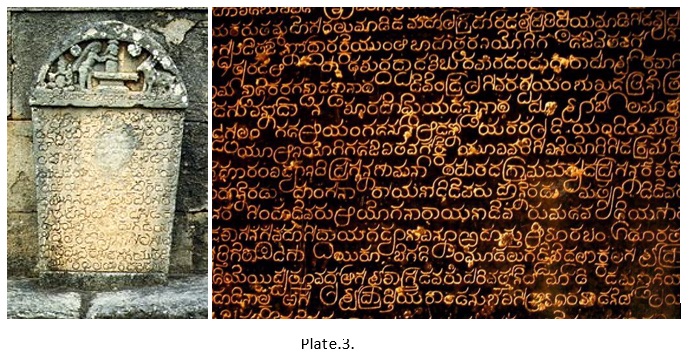
Fig.1. Old Kannada inscription (1113 CE) of Hoysala King Vishnuvardhana at Lakshmi Devi temple in Doddagaddavalli. Fig.2. Inscription at Somanathpur temple of Hoysala period.

Kannada inscription of King Krishnadeva Raya, dated 1509, at the Virupaksha temple in Hampi, describing his coronation and the construction of the large open mantapa. Vijayanagara Inscription of Sadashivaraya at Lakshmeshwara, 16th century AD (Source: Karnataka itihasa academy)
The present day Kannada script – Hosagannada
The present day hosagannada is evolved from old Kannada script. The alphabetical order of script of Kannada language, 49 in number, written from left to right, follows the order of vowels and consonants. Each sound has its own distinct letter. The 49 letters are classified into Swara (vowels,14 in number), Vyanjana (consonants, 35 in number of which 25 are structured according to the pronunciation and 10 are considered as un structured that do not belong to any category) . Yogavahakas (part vowel and part consonant) are two in number which are attached to the vowel ‘A’ to give nasal tone of ‘am’ or a Visarga of ‘aha’. The consonants, based according to the sound produced by the vocal organs, especially the tongue. They are categorized as Velars, Palatals, Retroflex, Dental and Labial consonants. Approximants, (diacritics), Sibilants (ottakshara) are also a part of the script chart. Each letter called akshara has its own form (akara) and sound (Shabda) providing the visible and audible representations. Kannada syllables are alpha syllabary where all consonants have the inherent vowel. The consonant-vowel sequences are written as a unit. Each unit is based on a consonant letter and vowel notation is secondary. Each vowel has two forms-the independent form and the extended form that are attached to the consonants. Vowels are indicated with the diacritics which appear either above, below or by the side of the consonant as an appendage symbol. Though the letters in Kannada are 49 in number, the number of written symbols are far more because different sibilants that produce the stressing sound of a particular consonant character (called ottaksharas) can be combined with any letter in various combinations. This gives rise to compound characters and each word is pronounced exactly as it is spelt.

Diacritics attached to a consonant. The sibilant charactars called “ottaksharas” used with consonants.
Geometric curves
Source – 1. Wikipedia, the free encyclopedia. 2. Curve-article about the curve by The free dictionary
Geometric and algebraic curves are so called because the different points are constructed by the operation of elemental geometry. Curves are defined as a smoothly flowing line with no sharp changes and they bend or change the direction without sharp change. The curves are observed in nature, and human beings have used them in the art productions, ornaments, machines, notably architectural—for example, the whorl or coil pattern. This paper is focused on the adoption of spirals and curves in the alphabets of Kannada language.
1) Hyperbola curve is an open curve which continues indefinitely rather than closing. Hyperbola curve has two curves called arms or axis. The Transverse axis is the major one and the other is the perpendicular axis. The point where they meet is the radius of curvature. This type of curve is identified in Kannada as “Talekottu” which is attached to all consonants on top.
The eccentricity of a hyperbola is greater than one. If a right circular cone is intersected by a plane parallel to its axis, part of a hyperbola is formed. Such an intersection can occur in physical situations as the shapes formed on wall by lamp shades.
2) A parabola is a two-dimensional mirror image of a curve which is approximately in a U shape. The consonant ‘Ga’ is derived from attaching the hyperbola curve (as talekottu) on the parabola curve.
The eccentricity of a parabola is one of nature’s best known approximations to parabolas is the path taken by a body projected upward and obliquely to the pull of gravity, as in the parabolic trajectory of a golf ball. The friction of air and the pull of gravity will change slightly the projectile’s path from that of a true parabola. Parabolas exhibit unusual and useful reflective properties, also in acoustics. If a bulb is placed at the focus of a parabolic mirror the light will be reflected in rays parallel to said axis. In this way a straight beam of light is formed. This unique property of a parabola might have been the inspiration to use it as an alphabet Ga.
3) A dumb bell spiral is an implicit plane curve emerging as a set of zeroes. A hyperbola curve is attached on top of dumb bell curve to get the consonant ‘ha’.
In the atomic orbitals are undergoing hybridization to form stable molecules. The energy of the orbitals is decided by various factors like symmetry, electron density distribution in space, electronic interaction between orbitals etc., These factors are favourable and maximum stability attained in the dumbbell orientation. This is also seen in a standing wave pattern.
4) Helix spiral -Archimedean spiral: The curves wind around a fixed center point at a continuously decreasing or may be increasing distance from the point, looking like a conical coiled spring. It is a curve on a plane that winds around a fixed center point at a continuously increasing or decreasing distance from the point. Helix is a three-dimensional curve that turns and twists around an axis at a constant or continuously varying distance while moving parallel to the axis. The consonant ta is in the shape of a helix spiral.
A helix is a type of smooth space curve, i.e. a curve in three-dimensional space. It has the property that the tangent line at any point makes a constant angle with a fixed line called the axis. Examples of helices are coil springs and the handrails of spiral staircases. A “filled-in” helix – for example, a spiral ramp – is called a helicoid. In music, pitch space is often modelled with helices or double helices, most often extending out of a circle such as the circle of fifths, so as to represent octave equivalency.
5) Lituus, a Hyperbolic spiral is a transcendental plane curve with a polar point. It begins with an infinite distance from the pole in the Centre and winds faster as it approaches the pole. It is also called Lituus which is with a polar curve. This particular symbol called “Etva” when attached to a consonant on top to give the diacritic mark of E like ka becomes ke or ra becomes re. Somewhat a similar symbol when drawn below the consonant becomes the sibilant mark of ta attached to a consonant.
6) Logarithmic spiral: The logarithmic spiral occurs in nature. It can be distinguished by the fact that the distances between the turnings of a logarithmic spiral goes in a mathematical progression exhibiting self-similarity pattern. The vowel A and the consonant La is based on this geometry. In the vowel ‘A’, the spiral involute and the margin is turned inwards to indicate about the “hrisva” or short pronunciation. In the extended form, ‘A’ the spiral margin turns into a curve to indicate about the grammatical aspect of extension of power. Logarithmic spirals seem to have varied application in Kannada alphabets. The margin when it does not involute is pronounced as the consonant La.
Fbonacci spiral
One special case of these logarithmic spirals are the approximate Fibonacci spirals- the golden spirals that occur in nature (for example, the sun flower or cone of a pine the arms of spiral galaxies). It is sometimes stated that spiral galaxies get wider in the pattern of a golden spiral, and hence are related to Fibonacci series. This pattern allows the organism to grow without changing shape. This spiral curve can be seen in the diacritic symbol of ‘EE’, called ‘dirgha’ the extension. It is placed next to a consonant that is already attached to a lituus curve, to give an extended phonetic pronunciation Like ge or ke (ga+lituus becomes ge) will be pronounced as gee or kee with this mark. Spirals are common in plants and in some animals, notably molluscs. For example, in the nautilus, a cephalopod mollusc, each chamber of its shell is an approximate copy of the next one, scaled by a constant factor and arranged in a logarithmic spiral. Given a modern understanding of fractals, a growth spiral can be seen as a special case of self-similarity, that has been used as an extension mark.
7) Euler or cornu spiral is a track transitional and mathematically calculated curve where a straight section changes into a curve and the line thickens inside.
Euler spiral is a curve whose curvature changes linearly with its curve length (the curvature of a circular curve is equal to the reciprocal of the radius). Euler spirals are also commonly referred to as spiros, clothoids, or Cornu spirals. The Cornu spiral can be used to describe a diffraction pattern.
8) Elliptic curve in geometry is an algebraic plane curve, the graph of which has no cusps or intersection. They are confined to a region of space or finite field. They are used in cryptography. Elliptic curve may also get extended as a dual elliptic curve. (UU).(The figure of a moving snake might have been an inspiration to depict UU that gives a phonetic sound with the lips that has to be thrust forward to produce this particular sound.)
An elliptic curve is not an ellipse (oval shape), but is represented as a looping line intersecting two axes. Equations based on elliptic curves have a characteristic that is very valuable for cryptography purposes: they are relatively easy to perform, and extremely difficult to reverse.
9) Transcendental curve may be intersecting any line in multiple number of points. The sibilant characters of consonants Na and Ma are based on this curve pattern.
It is a plane curve whose equation in rectangular Cartesian coordinates is not algebraic. In contrast to algebraic curves, transcendental curves can have an infinite number of points of intersection with a straight line and an infinite number of points of inflection. Examples of transcendental curves are spirals, cycloid or the catenary– a curve formed by a rope or a chain, etc.
10) Cycloid curve is generated by a circle rolling on another curve. They have cusps forming an arch called the arch of cycloid. Cycloid curves are used both in a vowel and in consonants of palatals group. (See consonants-palatals like cha ja jha, etc.)
11) Epicycloidal curve is also a plane curve produced by tracing a path of a chosen point on the circumference of the circle. It rolls without slipping or intersection like a roulette. This type of curve is used in some of dentals group of consonants like Da and Dha (see fig. 8 for dentals)
12) Prolate cycloid curves are cycloid curves but have loops. This type of curve is used in the retroflex group of consonants (the tongue has to curve a bit to give this group of pronunciation)
A Prolate cycloid is a cycloid where the locus is drawn from a point farther from the center of the circle than the circle’s circumference
13) Hypo cycloidal curve: The curve has loops like paddles that are symmetrically distributed around the pole. The loops are called petals and can be seen in the consonants Na and Sa. The curves also resemble the elliptical curves.
14) Curve spiral is like the galaxy spiral arm. This feature is attached to a consonant when the vowel U adheres to the consonant like consonant Ga becomes Gu or Ka becomes Ku. It is a diacritic mark to indicate the vowel U.
A spiral is a curve in the plane or in space, which runs around the center in a special way. Spirals are used to overcome the abrupt changes in curvature and super elevation that occurs between tangent and circular curve. The spiral curve is used to gradually change the curvature and thus called a transition curve.
15) Bezier curve is also a polynomial smooth curve or spiral that avoid unnecessary wear. It has several undesirable features, including a non-intuitive variation of a fitting curve with varying co efficient. It is a curve with four points, the initial and end points called the anchors and the middle points called the handles. A Bezier curve can be altered indefinitely by moving the middle points or the handles. This curve can be seen in the consonant Kha or Sha. Even the sibilant mark of Ya is shaped like this curve.
16) Circles: In Ancient culture the circle was thought of as the perfect shape, a symbol of the divine symmetry and balance in nature. The ancient Indian mathematicians were fascinated by the geometry of circles and explored their properties for centuries. Circle is defined as plane figure bound by one line, with the locus of a point which moves such that its distance from a given fixed point as canter is constant. The circle is drawn with a centre point and the binding line is the circumference. The consonant Ra is a full circle and Tha is identified like Ra with the centre dot. The line that touches the circle is the coplanar straight line as seen in the consonant ‘Ka’. Segment of a circle is also used as a sibilant of consonant Ra.
Conclusion
Though immense work has been done in the field of evolution of Kannada script tracing its origin from Brahmi script, the fact of why a specific design was chosen to illustrate a particular letter has not been deciphered. An attempt has been made here to illustrate the probable structure of letters to the specific geometric formula. The contributions of the ancient geometricians of the southern India in the paleographic structuring of the alphabets of Kannada from the mother version of Brahmi script still needs to be explored.
References
- The Cultural Heritage of India volume VI, science and technology, by the Ramakrishna mission institute of culture, Calcutta.
- https://karnatakaitihasaacademy.org/karnataka-history/evolution-of-Kannada-script/1. Old
- http://www.omniglot.com/writing/Kannada.htm
- Blog-” Arun’s Collection of Ancient Indian Coins.”
- Kannada alphabet, pronunciation and language
- Kannada Alphabets-Wikipedia. https://en.wikipedia.org/wiki/Kannada_alphabet
- Polynomial Curve — from Wolfram MathWorld
- wolfram.com › Geometry › Curves › Plane Curves › Algebraic Curves
- Curve-Wikipedia, the free encyclopaedia. https://en.m.wikipedia.org/wiki/Curve
- Coordinate Geometry by S.K.Goyal
- ISC Mathematics Book II by O.P.Malhotra, S.K.Gupta, Anubhuti Gangal
- Mathematics by S.S.Bosco
My thanks to Smt. Surekha Jayaprakash, a national merit scholarship holder and a science teacher for reviewing and providing details on the geometrical inputs.
Independent Researcher and Indologist, Mysore

